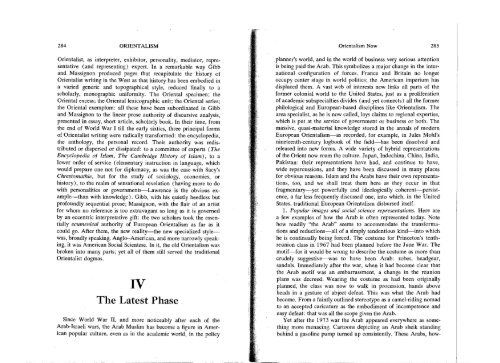Orientalism - autonomous learning
Orientalism - autonomous learning
Orientalism - autonomous learning
You also want an ePaper? Increase the reach of your titles
YUMPU automatically turns print PDFs into web optimized ePapers that Google loves.
284 ORIENTALISM<br />
<strong>Orientalism</strong> Now<br />
285<br />
Orientalist, as interpreter, exhibitor, personality, mediator, representative<br />
(and representing) expert. In a remarkable way Gibb<br />
and Massignon produced pages that recapitulate the history of<br />
Orientalist writing in the West as that history has been embodied in<br />
a varied generic and topographical style, reduced finally to a<br />
scholarly, monographic uniformity. The Oriental specimen; the<br />
Oriental excess; the Oriental lexicographic unit; the Oriental series;<br />
the Oriental exemplum: all these have been subordinated in Gibb<br />
and Massignon to the linear prose authority of discursive analysis,<br />
presented in essay, short article, scholarly book. In their time, from<br />
the end of World War I till the early sixties, three principal forms<br />
of Orientalist writing were radically transformed: the encyclopedia,<br />
the anthology, the personal record. Their authority was redistributed<br />
or dispersed or dissipated: to a committee of experts (The<br />
Encyclopedia of Islam, The Cambridge History of Islam), to a<br />
lower order of service (elementary instruction in language, which<br />
would prepare one not for diplomacy, as was the case with Sacy's<br />
Chrestomathie, but for the study of sociology, economics, or<br />
history), to the realm of sensational revelation (having morc to do<br />
with personalities or governments-Lawrence is the obvious example-than<br />
with knowledge). Gibb, with his quietly heedless but<br />
sequential prose; Massignon, with the flair of an artist<br />
for whom no reference is too extravagant so long as it is governed<br />
by an eccentric interpretative gift: the two scholars took the essentially<br />
ecumenical authority of European <strong>Orientalism</strong> as far as it<br />
could go. After them, the new reality-the new specialized stylewas,<br />
broadly speaking, Anglo-American, and more narrowly speaking,<br />
it was American Social Scientese. In it, the old <strong>Orientalism</strong> was<br />
broken into many parts; yet all of them still served the traditional<br />
Orientalist dogmas.<br />
IV <br />
The Latest Phase <br />
Since World War II, and more noticeably after each of the<br />
Arab-Israeli wars, the Arab Muslim has become a figure in American<br />
popular culture. even as in the academic world, in the policy<br />
planner's world, and in the world of business very serious attention<br />
is being paid the Arab. This symbolizes a major change in the international<br />
configuration of forces. France and Britain no longer<br />
occupy center stage in world politics; the American imperium has<br />
displaced them. A vast web of interests now links all parts of the<br />
former colonial world to the United States, just as a proliferation<br />
of academic subspeciaIties divides (and yet connects) all the former<br />
philologic:;y, and European-based disciplines like <strong>Orientalism</strong>. The<br />
pecialist, as he is now called, lays claims to regional expertise,<br />
is put at the service of government or business or both. The<br />
massive, quasi-material knowledge stored in the annals of modern<br />
European <strong>Orientalism</strong>-as recorded, for example, in Jules Mohl's<br />
nineteenth-century logbook of the field-has been dissolved and<br />
re;leased into new forms. A wide variety of hybrid representations<br />
of the Orient now roam the culture. Japan, Indochina, China, India,<br />
Pakistan: their representations have had, and continue to have,<br />
wide repercussions, and they have been discussed in many places<br />
for obvious reasons. Islam and the Arabs have their own representations,<br />
too, and we shall treat them here as they occur in that<br />
fragmentary-yet powerfully and ideologically coherent-persistence,<br />
a far less frequently discussed one, into which, in the United<br />
States, traditional European <strong>Orientalism</strong> disbursed itself.<br />
1. Popular imar:es and social science representations. Here are<br />
a few examples of how the Arab is often represented today. Note<br />
how readily "the Arab" seems to accommodate the transformations<br />
and reductions-all of a simply tendentious kind-into which<br />
he is continually being forced. The costume for Princeton's tenthreunion<br />
class in 1967 had been planned before the June War. The<br />
motif-for it would be wrong to describe the costume as more than<br />
crudely<br />
to have been Arab: robes, headgear,<br />
sandals. Immediately after the war, when it had become clear that<br />
the Arab motif was an embarrassment, a change in the reunion<br />
plans was decreed. Wearing the costume as had been originally<br />
planned, the class was now to walk in procession, hands above<br />
heads in a gesture of abject defeat. This was what the Arab had<br />
become. From a faintly outlined stereotype as a camel-riding nomad<br />
to an accepted caricature as the embodiment of incompetence and<br />
easy defeat: that was all the scope given the Arab.<br />
Yet after the 1973 war the Arab appeared everywhere as something<br />
more menacing. Cartoons depicting an Arab sheik standing<br />
behind a gasoline pump turned up consistently. These Arabs, how
















